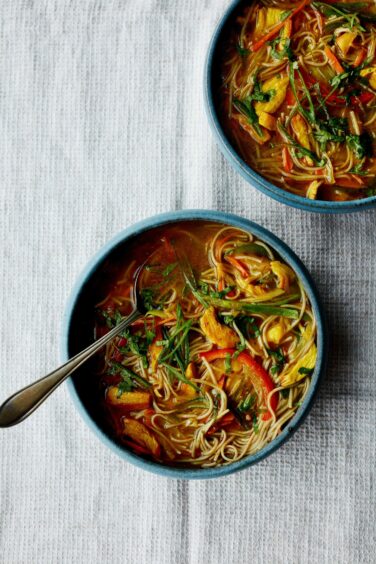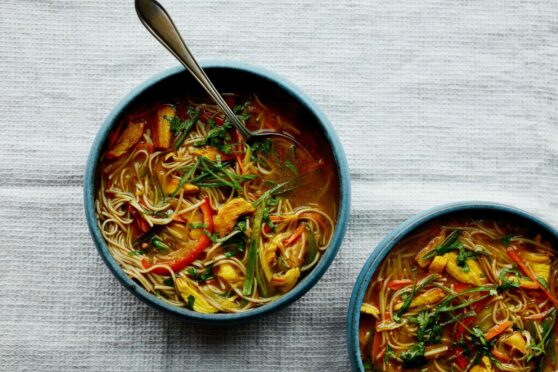Healthy, hearty and comforting on a cold day, Thukpa is a soup shared by both the Nepali and Tibetan Sherpa communities.
“To handle the freezing winters in high altitude, their diet is heavily based on carbohydrates,” explains Santosh Shah in his cookbook, Ayla.
“The soup is laced with the uplifting warmth of cumin, turmeric and timmur peppercorns. Some cooks add cornflour to thicken the soup, but I prefer a thinner broth with my noodles.”
Looking for more dinner inspiration? Check out our line-up of Midweek Meal recipes here.
Thukpa
(Serves 4)

Ingredients
- 100g soba noodles, or egg noodles
- 3tbsp vegetable oil
- ½ tsp hing (asafoetida)
- 300g free-range chicken breast, finely chopped
- ½ tsp ground turmeric
- 50g finely chopped carrots
- 180g finely chopped mixed peppers
- 50g thinly sliced green French beans
- 80g finely shredded white cabbage
- 1 tsp salt
- 800ml chicken stock
- 2 tbsp fresh coriander, chopped
- 1 lemon, quartered, to serve (optional)
For the spice paste:
- 1 large garlic clove
- 4 tsps finely chopped fresh ginger
- 4 fresh green chillies, roughly chopped
- ½ tbsp cumin seeds, dry roasted
- 5 Sichuan or timmur peppercorns (timmur is native to Nepal and is a cousin of the Sichuan peppercorn)
- ¼ tsp black peppercorns
- 1 tbsp fresh coriander, chopped
- 1 small tomato, deseeded and chopped
Method
- Start by making the spice paste. Place all the ingredients for the paste except the tomato in a small food processor or electric spice grinder. Blend until you get a paste. Add the tomato and blend again. You should get a smooth, spoonable paste. You can make this in advance and keep refrigerated for 2-3 days, or freeze for one month.
- Cook the noodles according to the packet instructions and set aside.
- Heat the oil in a large saucepan over medium heat. Stir in the hing and cook for a few seconds. Add the chicken and cook for five minutes, until slightly golden. Add the turmeric and cook for one minute.
- Add all the vegetables and stir-fry for a couple of minutes. Stir in the salt and spice paste until all the ingredients are well coated. Cook for a couple of minutes.
- Pour in the chicken stock, bring to the boil, reduce the heat and simmer for five minutes. Add the noodles and cook for a couple of minutes, just enough to reheat them.
- Adjust the seasoning to taste, add the chopped coriander and serve with lemon quarters for squeezing over.
Ayla: A Feast Of Nepali Dishes From Terai, Hills And The Himalayas by Santosh Shah is published by DK, priced £20. Available now.










